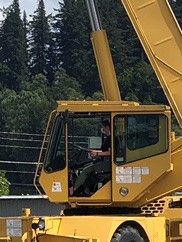When severe weather conditions come into play, the risks and challenges of operating mobile cranes multiply, making it crucial for operators and site managers to be well-prepared. Here we explore the various impacts of severe weather on mobile crane operations and discuss training options and safety precautions that you and your team can take advantage of during inclement weather.
High Winds - A Major Threat to Stability
One of the most significant threats to mobile crane operations is high winds. As many of you know, cranes are particularly vulnerable to wind due to their height and the nature of their loads. High winds can cause instability and even tipping, posing serious risks to both the crane operator and ground personnel. Additionally, strong winds make it challenging to control loads, increasing the likelihood of accidents. Below you can see a training scenario taking place in the ITI VR Crane Simulator, which features varying wind conditions, designed to challenge operators.
To mitigate these risks, it's essential to adhere to manufacturer guidelines on maximum safe wind speeds. Operations are typically halted if wind speeds exceed certain thresholds. Regular wind speed monitoring and having a clear wind action plan are vital components of safe crane operation.
Rain - Visibility Concerns
Heavy rain can severely impact mobile crane operations by reducing visibility for the operator. Poor visibility makes it difficult to perform precise maneuvers, increasing the risk of collisions and accidents. Furthermore, rain can create slippery surfaces, compromising the stability of the crane and endangering ground personnel.
In rainy conditions, it's important to ensure that all surfaces are as dry and secure as possible. Using anti-slip materials and ensuring proper drainage can help mitigate some of these risks.
Lightning - A Dangerous Electrical Hazard

Cranes can essentially act as lightning rods during thunderstorms, presenting a severe risk of electrical shock. It is crucial to stop crane operations and ground the crane properly when there is a threat of lightning. Implementing a lightning safety plan and monitoring weather forecasts can help prevent accidents.
Snow and Ice - Added Weight and Mechanical Issues
 Snow and ice pose unique challenges for mobile crane operations. Accumulations of snow and ice add extra weight to both the crane and its loads, affecting load stability and crane capacity. Cold temperatures can also impact the mechanical components of the crane, making them brittle and prone to failure. Hydraulic systems may operate less efficiently in extreme cold, further complicating operations.
Snow and ice pose unique challenges for mobile crane operations. Accumulations of snow and ice add extra weight to both the crane and its loads, affecting load stability and crane capacity. Cold temperatures can also impact the mechanical components of the crane, making them brittle and prone to failure. Hydraulic systems may operate less efficiently in extreme cold, further complicating operations.
Regularly removing snow and ice from the crane and its components, as well as performing frequent mechanical checks, are essential practices in cold weather.
Flooding - Ground Stability and Accessibility
 Flooding can severely affect the stability of the ground on which cranes operate, increasing the risk of sinking or tipping. Additionally, flooded areas can restrict access to the worksite, delaying operations and complicating logistics.
Flooding can severely affect the stability of the ground on which cranes operate, increasing the risk of sinking or tipping. Additionally, flooded areas can restrict access to the worksite, delaying operations and complicating logistics.
Ensuring that the ground is stable and secure before operating the crane in flood-prone areas is crucial. Planning alternative routes and having contingency plans for site accessibility is always wise as it can help maintain operational efficiency during floods.
Essential Safety Precautions
When in doubt, it's always a good idea to consider the following precautions:
- Weather Monitoring: Regularly monitor weather conditions using reliable forecasts and real-time updates. This helps in planning and making informed decisions.
- Load Calculations: Adjust load calculations to account for additional weight from snow, ice, or water. This ensures stability and safety.
- Securing the Crane: Properly secure cranes during severe weather by lowering booms and moving cranes to sheltered areas if possible.
- Emergency Plans: Have a clear emergency response plan in place. Ensure all personnel know how to react and stay safe during severe weather events.
Training with ITI
Interested in learning more? Check out our online course, Severe Weather Effects on Crane Operations. This 30 minute online course is designed to address how environmental factors, specifically weather, can impact crane operations. The course modules consist of narrated videos, reference materials, and interactive elements intended to solidify key learning objectives.

About ITI
Industrial Training International (ITI) is a global leader in the design and delivery of learning solutions for organizations conducting crane, rigging, and load handling activities. Founded in 1986, the company originally specialized in instructor-led training, field services, and consulting. ITI has since grown to also produce live online, and on-demand courses delivered via the ITI Learning Hub and has been recognized with numerous industry association awards for its groundbreaking virtual reality crane simulator solution. For more information about ITI, visit iti.com.





COMMENTS